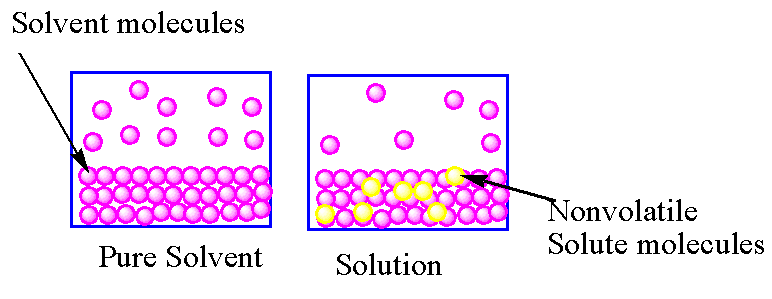
State and explain Raoult’s law.
Answer
474k+ views
Hint: Raoult’s law explains the change in vapour pressure of the solvent in the solution. Raoult’s law applies to ideal solutions at any concentration while for real solutions law is applicable only to dilute solutions.
Complete step by step answer:
Raoult’s law states that vapour pressure of the solvent in a solution is the product of mole fraction of solvent and vapour pressure of the pure solvent.
The mathematical expression of Raoult’s law is as follows:
${P_{{\text{solution}}}} = {X_{{\text{solvent}}}} \times P_{{\text{solvent}}}^ \circ $
Here,
${P_{{\text{solution}}}}$= vapour pressure of the solution
${X_{{\text{solvent}}}}$ = mole fraction of solvent
$P_{{\text{solvent}}}^ \circ $= vapour pressure of the pure solvent
Raoult’s law is valid for the solution of non-volatile and non-electrolytic solute. The vapour pressure of such a solution is always lower than the vapour pressure of the pure solvent.

In the case of a pure solvent , the rate of vaporisation and condensation are equal. In case of solution due to the presence of solute particles on the surface of the solvent, the rate of vaporisation is lower than the rate of vaporisation of the pure solvent. So in solution, to achieve equilibrium, the gaseous molecules convert into liquid due to which, the vapour pressure of a solution is lower than the vapour pressure of the pure solvent.
Another factor which causes vapour pressure lowering is the increasing entropy. The solution has higher entropy than pure solvent so the solution has a lower rate of vaporisation than the pure solvent.
Raoult’s law is also applicable for the solution of non-volatile liquid pairs like a solution of benzene and toluene, n-hexane and n-heptane etc.
So, the correct answer is “Option A”.
Note:
Lowering in vapour pressure of a solution is one of the colligative properties explained by Raoult's law. Ideal solutions obey Raoult’s law at all concentration and temperature. Real solutions show deviation to Raoult’s law at higher concentration while dilute solutions obey Raoult's law.
Complete step by step answer:
Raoult’s law states that vapour pressure of the solvent in a solution is the product of mole fraction of solvent and vapour pressure of the pure solvent.
The mathematical expression of Raoult’s law is as follows:
${P_{{\text{solution}}}} = {X_{{\text{solvent}}}} \times P_{{\text{solvent}}}^ \circ $
Here,
${P_{{\text{solution}}}}$= vapour pressure of the solution
${X_{{\text{solvent}}}}$ = mole fraction of solvent
$P_{{\text{solvent}}}^ \circ $= vapour pressure of the pure solvent
Raoult’s law is valid for the solution of non-volatile and non-electrolytic solute. The vapour pressure of such a solution is always lower than the vapour pressure of the pure solvent.

In the case of a pure solvent , the rate of vaporisation and condensation are equal. In case of solution due to the presence of solute particles on the surface of the solvent, the rate of vaporisation is lower than the rate of vaporisation of the pure solvent. So in solution, to achieve equilibrium, the gaseous molecules convert into liquid due to which, the vapour pressure of a solution is lower than the vapour pressure of the pure solvent.
Another factor which causes vapour pressure lowering is the increasing entropy. The solution has higher entropy than pure solvent so the solution has a lower rate of vaporisation than the pure solvent.
Raoult’s law is also applicable for the solution of non-volatile liquid pairs like a solution of benzene and toluene, n-hexane and n-heptane etc.
So, the correct answer is “Option A”.
Note:
Lowering in vapour pressure of a solution is one of the colligative properties explained by Raoult's law. Ideal solutions obey Raoult’s law at all concentration and temperature. Real solutions show deviation to Raoult’s law at higher concentration while dilute solutions obey Raoult's law.
Recently Updated Pages
How do you factor x2 + x 20 0 class 9 maths CBSE

How do you solve y6x and 2x+3y20 using substitutio class 9 maths CBSE

Chipko movement originated in Gopeshwar in A 1953 B class 9 biology CBSE

The adjacent sides in the parallelogram are supplementary class 9 maths CBSE

The compound used in plastic industry is A Vinyl acetate class 9 chemistry CBSE

How do you solve for y in 2left y dfrac12 right 4left class 9 maths CBSE

Trending doubts
Types of lever in which effort is in between fulcrum class 12 physics CBSE

Distinguish between esterification and saponification class 12 chemistry CBSE

Which are the Top 10 Largest Countries of the World?

A two input XOR Gate produces a high output only when class 12 physics CBSE

Give five points to show the significance of varia class 12 biology CBSE

Which is the correct genotypic ratio of mendel dihybrid class 12 biology CBSE




